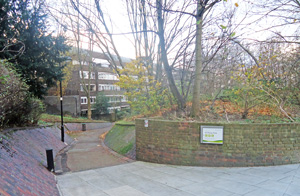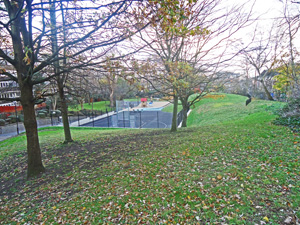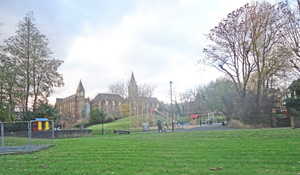|
Whittington College Archway Road, Islington, N19 3UL |
At the beginning of the 19th century the Mercers Company wished to expand both its School and its almshouses (Whittington College), both located in College Hill in the City of London. The Company decided to build new almshouses on 6 acres of land it owned at the Turnpike by the Highgate Archway.
Before work could begin on the almshouses in 1820, the site had to be cleared of spoil from the roadworks on the Archway Road, newly constructed some ten years earlier.
The new College was completed in 1824, at a cost of almost £20,000. It consisted of a two-storey central block (with a chapel in the middle) and two wings enclosing a quadrangle. At the end of one wing was accommodation for the tutor (chaplain) and at the other for the Matron.
The chapel, designed like the almshouses in the Gothic style, also had a Gothic interior with stalled seats for the almswomen. Church of England services were held twice on Sundays.
The quadrangle, whose open side faced the road, was a pleasure garden, planted with flowers, shrubs and evergreen trees, and intersected by gravel paths. Near the centre was a stone statue of Sir Richard Whittington as a boy, seated on the stone by the highway, listening to the bells ringing out "Turn again, Whittington". The public was allowed to use the grounds at all times, except when services were being held in the chapel.
Each of the 24 almshouses had two rooms and a kitchen. The inhabitants were all single women over the age of 55 years at the time of their admittance.
None were allowed to possess an annual income of more than £30 in addition to their annual stipend of £30. The 12 women transferred from the original almshouses in College Hill received somewhat more, as well as coal money. The almswomen received medical attendance and nurses to care for them when ill.
In 1860 it was found necessary to improve the drainage system by opening a drain from the College to the main sewer, at a cost of £1,100.
By 1884 the almshouses had been extended to 30 dwellings. As before, the front house of each wing was occupied by the tutor (the chaplain), with a salary of £125 a year, and the Matron (£54 a year). Two detached houses were also added to the site - one for the gardener, who was paid 1 guinea (£1.05) a week, and one for the nurse, who was paid £40 a year. A fund for out-pensioners had been created, to which both sexes were eligible.
Plans to rebuild the College and upgrade the accommodation in the mid 20th century were thwarted by the Ministry of Transport's decision to widen Archway Road in 1962. The almshouses and their land were sold to the LCC.
In 1965 a site in Felbridge, near East Grinstead, was purchased by the Mercers Company on which to build a new Whittington College. The buildings were completed in 1966 and the residents moved to their new accommodation on 29th September of that year.
Current status
The almshouses were demolished in 1967. The allotment gardens behind the almshouses became housing - Henfield Close - but the site of the almshouses themselves became a public park - Archway Park. The park was refurbished in 2017 and formally re-opened on 30th September.N.B. Photographs obtained in November 2017

The entrance to the park.

The park, as seen looking towards the south.

Looking towards the north, towards the former Archway Hospital.
References (Accessed 24th June 2021)
(Author unstated) 2017 The Mercers Company Annual Review, 24.
Cromwell T 1835 Walks Through Islington. London, Gilbert, Sherwood & Piper. 330-337.
Herbert W 1834 The History of the Twelve Great Livery Companies of London, Vol. 1. London, self-published. 250.
Roe J, Lemoine A 1810 The Fortunate History and Adventures of Sir Richard Whittington. London, self-published. 26-31.
Shepherd TH 1829 Metropolitan Improvements: Or, London in the Nineteenth Century. London, Jones & Co. 141-142.
https://artcollection.culture.gov.uk
https://janeaustenlondon.com
https://library.artstor.org
https://wellcomecollection.org (1)
https://wellcomecollection.org (2)
www.alamy.com
www.britainfromabove.org.uk
www.british-history.ac.uk (1)
www.british-history.ac.uk (2)
www.britishmuseum.org
www.facebook.com
www.gardenvisit.com
www.londonpicturearchive.org.uk
www.londonremembers.com
www.lookandlearn.com
www.sandersofoxford.com
www.tate.org
www.whpara.org.uk
Last updated 24th June 2021
Click here to return to Almshouses of London alphabetical list
Click here to return to home page